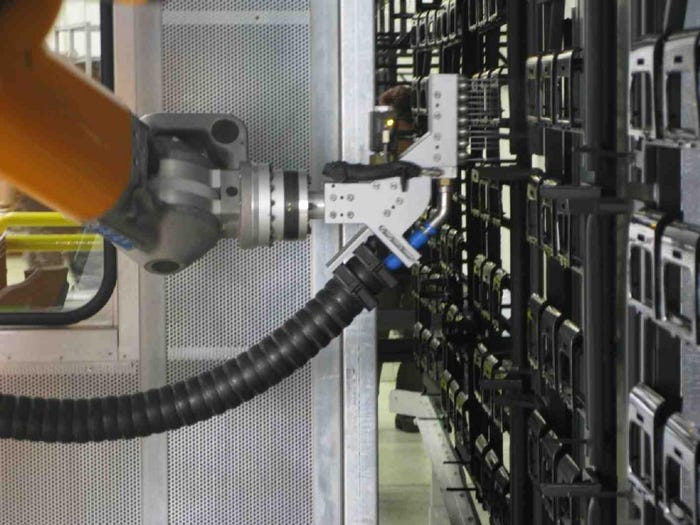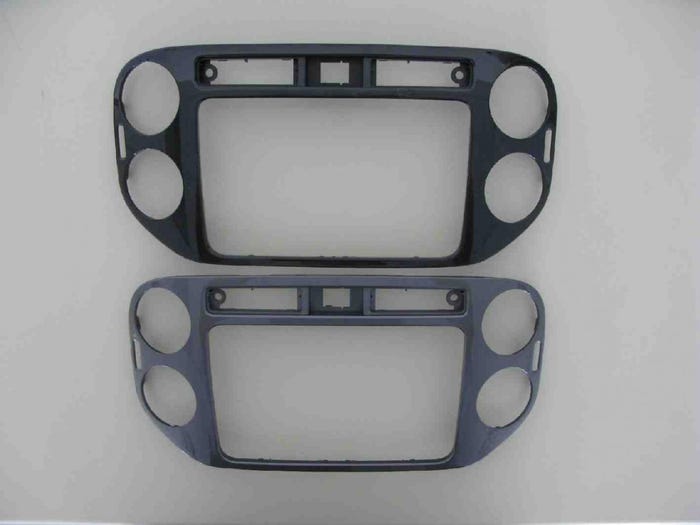Volkswagen hot on CO2 snow jet system for plastic interior components
Since August 2010, the Volkswagen Plastics Technology facility in Braunschweig, Germany has been using the CO2 snow jet technique to clean interior components before painting.
September 12, 2011
Since August 2010, the Volkswagen Plastics Technology facility in Braunschweig, Germany has been using the CO2 snow jet technique to clean interior components before painting. We first reported on the snow jet system for cleaning plastic automotive parts last February in this article on the use of the system by BMW. Supplier of these snow jet systems is a German company called acp (advanced clean production GmbH).
|
Top: After cleaning with the snow jet, a single layer of semi-transparent paint is applied to an injection molded panel. Below: Component-specific cleaning programs are filed in the robot controls for approximately 20 different workpieces. |
|
For BMW the snow jet system from acp is used to clean exterior plastic parts before applying a primer. Among the reasons BMW cited for its switch from a powerwash system to a CO2"snow jet" system are lower costs, a more environmentally sustainable process, improved quality, plus a reduced footprint in the carmaker's facility.
For VW, which is using the snow jet system to clean interior plastic automotive parts, aims are to improve quality, and to realize better cost-efficiency and a more sustainable process. The ease of automation and the low space requirements of the cleaning system also are attractive, according to VW. The process enables high-gloss injection molded components to be cleaned gently and efficiently before a single layer of metallic paint is applied. Those interior components include panels, trims, ventilation grilles and air diffusers made at Volkswagen Plastics Technology.
One of the components produced is a decorative panel made of an ABS/PC (acrylonitrile-butadiene-styrene / polycarbonate) blend. Although the part already has a high-gloss surface as it is removed from the injection molding machine, it is subsequently coated with a layer of high-gloss metallic paint to give it a more sophisticated finish.
Efficient cleaning, gentle on the materials
Because the paint is applied without an undercoat, the tiniest dust particles or water marks would cause rejects. The cleaning system used therefore needs to be not only fast, economical and reproducible, but also dry and gentle on materials. At the same time, the cleaning system had to fit into a small space and be easily integrated into the painting process.
VW's tests on high-gloss components and conventional plastic parts showed that the CO2 snow jet technology from acp was capable of attaining the level of cleanliness required to pre-treat the entire spectrum of components before there are painted.
In contrast with a CO2 dry-ice jet, the snow jet cleaning technique uses liquid carbon dioxide as a medium, with this stored in tanks at Volkswagen Plastics Technology. The acp-designed and -manufactured systems are equipped with supersonic two-component ring nozzles in the cleaning head, giving them a high cleaning power despite relatively low carbon dioxide requirements. Liquid carbon dioxide expands on exiting the nozzle to form a mixture of snow and gas - the core jet. Oil-free compressed air is fed to the core jet as a jacketed jet, accelerating the non-toxic, non-combustible snow crystals to supersonic speed.
When the focused jet impacts on the surface of a component, the combination of mechanical, chemical and thermal forces cleans off particulate and filmy contamination without leaving any residues. The tiny non-abrasive snow crystals are said to ensure that even high-gloss surfaces keep their quality and remain undamaged during cleaning.
Custom configuration offers flexibility
The project managers at Volkswagen and acp developed a customized system configuration in line with the range of components produced at the carmaker's Plastics Technology operation in Braunschweig. It is made up of a nozzle array containing seven cleaning nozzles and controlled by a robot. Workpiece-specific cleaning programs are filed for each of the approximately 20 different interior components that need to be cleaned. The cleaning system has been integrated into a booth fitted with a continuous extraction unit. This prevents cleaned parts from becoming re-contaminated by dirt after it has been removed.
The CO2 snow jet system has been running in three-shift operations at the Braunschweig molding facility since August 2010. Several thousand plastic parts are cleaned by it every day. Apart from the advantages of the cost-benefit comparison and a higher, reproducible cleaning quality, the CO2 snow jet cleaning has also enabled reject rates to be lowered by around 3%.
About the Author(s)
You May Also Like




